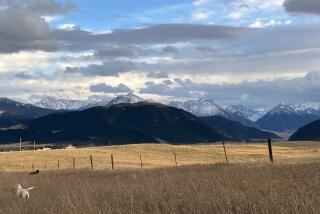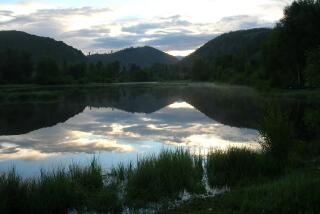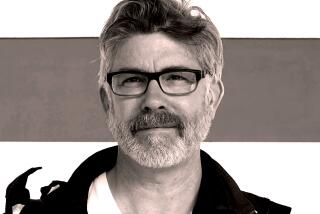You <i> Can</i> Go Home Again, but It Won’t Be Quite What It Was
- Share via
When I was growing up, my father and I often drove west 700 miles along Interstate 40 to visit our relatives. We lived on the East Coast--in New York City--and my father thought it was important to travel to Indiana, where he had grown up, where the Hastings family was rooted. We would always walk by the house he had lived in as a boy--a white-frame bungalow like thousands of others in America.
“Gee, the place has shrunk,” he would say, “and I don’t remember the streets being so narrow.” We would see the cousins and aunts and uncles who remained in Indianapolis and who still gathered each Sunday after church for dinner. We ate fried chicken and sipped iced tea, then lingered over homemade peach or apple pie. Evenings, we would catch a minor-league ballgame or drive downtown to watch the colored fountains in the plaza.
Nothing exciting, but when I recall those years, it’s those August trips with my father that I remember best--through Harrisburg, Pa., Wheeling, W. Va., and Columbus, Ohio, past cornfields that rose high in the summer heat, looking for the next Burma Shave sign, knowing that when we arrived, we were back home--where we had come from.
When my son turned 16, he began to drive, the phone rang even more, and the close-knit crowd he had known since kindergarten didn’t hang around the house so much. He began camping and skiing in the Sierra Nevada and surfing at Rincon in Ventura County and down in Baja. I watched my role as parent wind down and wondered what was left unsaid, undone.
Somehow, I realized, we had never made that drive to Indiana. Death and divorce have chipped away much of our sense of family. And our few remaining relatives always visit us in California. It became important to me to make that drive soon. I raised the question gently; it isn’t easy to lure a surfer from the ocean in August, with its promise of huge swells from Mexico.
We cleaned out our van and loaded it with duffels and a canvas bag filled with road maps and travel guides. We headed east on the Costa Mesa Freeway late one evening to avoid the desert heat. Seen from the start of our 2,500-mile journey, the freeway became unfamiliar, making us feel disconnected from the casual flow of Saturday night traffic.
We took turns at the wheel. The driver chose the music. Time seemed to shimmer in the asphalt as we cruise-controlled the length of Utah on a bright and dusty Sunday. That evening, in Jackson, Wyo., the wood-planked sidewalks were crowded with tourists like us. But the Grand Tetons rose dramatically out of their golden valley, and we agreed that this was a corner of the country we wanted to see again.
The West was especially dry, and deer, bison and antelope frequented the road-hugging creeks and canyons we passed. They were looking for water, we figured. We picked up Interstate 70 outside of Yellowstone, passing through rolling hills and small towns. Here, life would be a lot different from the fast pace we kept in California. A friend had sent along Garrison Keillor’s “Tales of Lake Wobegon” tapes, and I played them as we crossed the great, dark prairie one night.
One sleepy morning in Mitchell, S.D., we stopped at the world’s only Corn Palace, a building faced with a complicated mosaic of ears of corn and prairie grasses. Its paisley facade looked exotic--almost Byzantine--perched in this quiet town in the middle of the flatlands.
My son was at the wheel when we hit the rush hour in Chicago. The city’s noise jangled after the miles of mountains and plains. We headed for Comiskey Park to see the White Sox play. Traffic was stop-and-go, so we left the freeway to save time--a mistake, because we wound up lost in Cicero. By the time we pulled into the dirt lot across from the stadium, the game was beginning.
“Seven bucks,” said the parking attendant.
“Seven bucks?”
“This ain’t Disneyland, folks,” he said, with a nod at our California plates. We paid.
The next day, we pulled into Fennville, Mich., where our cousin John lives by the edge of a woods. We slept in old iron beds, under patchwork quilts made by a long-deceased great-aunt. John took us out to McClure’s Apple Farm for lunch. The barn, a dining hall now, has sat there 50 years or more in the midst of its own orchard. Rusted road signs, photographs and worn-out farm implements are nailed to the walls wherever there’s space. We ordered the apple pie a la mode that McClure’s is famous for, drank freshly crushed cider, sat back and relaxed. John entertained with stories--edited and embellished--of his college days at Purdue. Then we said our goodbys and headed south toward Indianapolis and Aunt Mary. The state roads squared off neatly into fields and forests, drawing us deeper into the heart of the country.
Aunt Mary said she was delighted to see us. She was apologetic about the front yard, because the sugar maple that stood in the center for the half-century she has lived there had to be taken out last autumn. A maple blight is moving through the Midwest, killing the big, old trees. She feels the yard looks bare without it, though we found her garden, which she still tends herself at age 79, to be fragrant with roses and packed with ripening tomatoes.
The next day, we drove by my father’s old house. Its white paint was weathered, and the fence, of a lacy wire seldom seen anymore, was torn. The house looked small. Later we sat on Aunt Mary’s porch to catch the breeze. We realized, though we didn’t want to admit it, how much time had gone by. She recalled a childhood visit to a graveyard in Freedom, south of town about an hour, where a great-grandfather was buried. She was sure that was where the Hastings family had settled when they had moved west from Connecticut in the early 1800s. We decided to drive down.
Along the way, we stopped in Spencer, the county seat. The library has a well-stocked genealogical section, and we leafed through the old records--births and marriages and deaths penned carefully into leather and cardboard ledgers. We discovered that our family had settled in Owen County during the 1840s. An Allen Hastings had been fined a dollar for assault and profanity in 1848. Later, he lost his farm in a mercantile venture with his son-in-law and lived out his days in the county asylum for the poor. And in a local history book, we read that the Rev. Wiley Hastings was pastor of the Freedom Christian Church for many years.
We tramped through an old cemetery, cut into the side of a hill overlooking Freedom, searching for the gravestone of this great-grandfather. It had taken an hour of inquiry at the general store and post office to find the cemetery, which has been all but overgrown. Decades of weather had blurred the granite monuments, and we finally left, our legs all weed-scratched, without success. But we believed a Hastings was there somewhere, and that seemed enough.
At Aunt Mary’s that evening, we sipped iced tea and thanked her for her hospitality. My aunt had stayed in the town she had been born and raised in, and her heritage was an unquestioned part of her life. But for myself, who has wandered from coast to coast, and my son, who has grown up in a beach town that has become a yuppie mecca, this journey had been one of discovery. We had experienced a large chunk of America from a close-up, road’s-eye point of view.
For a while, we had slowed down our lives and considered where our family had come from and what that meant. My son said that the trip had been like one to Lake Wobegon, “only ours was real.” I said that I had confidence in his driving, that now he could drive anywhere. “I know that,” he said. It was time to head home.
More to Read
Sign up for The Wild
We’ll help you find the best places to hike, bike and run, as well as the perfect silent spots for meditation and yoga.
You may occasionally receive promotional content from the Los Angeles Times.






